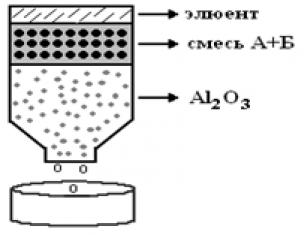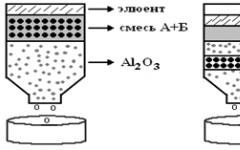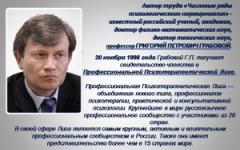Long interview with afterword
Writing about this library is very easy for me and... very difficult. This happens when you want to tell someone about a person close to you, about your favorite place. Can you really find words to express the significance and uniqueness of a place dear to you? I will try.
School No. 186 in Nizhny Novgorod (Nizhny Novgorod Author's Academic School (NAAS)) has a completely unusual library. In the very center of the school there is a huge, bright, two-level room. This is her. The author of the idea (or, if you prefer, co-designer) is director Mikhail Vasilyevich Burov. He came up with The kind of school library you always want to visit. And he began to create it.
Municipal educational institution– average secondary school No. 186 – Nizhny Novgorod author’s
academic school
But a room, even such a beautiful one, is only half the battle. The special space of the school library required a special quality of its use. That’s why librarians came up with the idea of creating a resource center. Such a project did not appear by chance; it was absolutely natural. The fact is that at school No. 186 the library was, frankly speaking, in a special position. It was (and is) the director’s favorite brainchild. He did everything possible to ensure that she developed as information center schools, so that the funds are not just regularly replenished, but enriched with the best publications. Even then it contained information educational resources on various media, a professional bibliographer was involved in the automation of library processes.
As you can see, the library was ready for transformation, and the project of creating a resource center did not seem like a pipe dream. The presentation of the project took place in October 2000. Government officials, entrepreneurs, and the press were invited. They all approved and supported the idea, which, I must say, was somewhat ahead of its time. Only in 2004 in official documents The Ministry of Education and Science spoke about the creation of a resource center on the basis of a school library - in the “Information on the main directions for improving the activities of institutional libraries general education Russian Federation».
In 2006, the school received significant funds from federal budget– within the framework of the implementation of the national project “Education”. Like many other educational institutions in the country, the Nizhny Novgorod school received support innovative development one million rubles. The teaching staff decided to use most of the funds for the development of the information resource center: for the purchase of books, audio and digital educational publications, for the purchase of additional equipment, furniture, and for redecorating the premises.
In December 2006, the official opening of the updated information and resource center took place. All. The fairy tale has become reality. Dot?
No, the fun is just beginning! Yes, a good idea was perfectly implemented. But I assure you that such an unusual library - resource center - is not just a source of pride for the school administration. The remarkable thing is that it has become one of the leading conditions for the implementation of all NAASH development plans, success factor to carry out all the transformations. But the school director, the head of the highest category, the honored teacher of the Russian Federation will tell you about this better Mikhail Vasilievich Burov.
Having done without preludes (after all, we have known each other for a long time), I decided to start the interview with a fundamental question.
Mikhail Vasilyevich, what is the essence of the resource center, why was it created?

Mikhail Vasilievich Burov – director of the Nizhny Novgorod copyright
academic school (NAAS), head of the highest category, excellent student of public education, honored teacher of the Russian Federation
I will talk about the resource center from the point of view of politics and meaning. And I'll start from afar. Today everyone is talking about the quality of education. By this, someone understands the presence of conditions, for example: there are good personnel, new educational technology There are computers in the pedagogical reserve. It seems that all this is quality education. Yes, probably, having such a set of components, we can mean that education at school will be of high quality. Someone compares Russian education with foreign ones, coming to the conclusion: our children do not know how to apply knowledge. At the same time, the need to develop different competencies in students is emphasized. Which ones? There is no single list, just as there is no holistic view, no overall picture. All interested parties (teachers, managers, parents, children) need to agree on what we want from the school, taking into account the needs of all participants in the educational process.
I am convinced that the final result of our educational activities– readiness of a school graduate for successful advancement in the educational, professional and social environment. In this regard, our school has identified five values that we focus on achieving in our work.
1. Profile. The task of NAASH is to create pedagogical conditions, in which each student will be able to receive an education that allows him not only to find a certain profile of educational activity, but also to develop the ability to learn independently, and, if necessary, relearn. Each student, together with teachers and parents, builds an individual educational route in accordance with their inclinations and abilities. This route passes through the basic and core areas of the school. At the same time, the task of teachers is to maximize the scope of student’s freedom of choice in learning environment; the student’s task is to make a responsible choice of educational route in accordance with his inclinations and abilities; The task of parents is to support individual educational routes children.
2. Career guidance. It is important that the child chooses the right profession. And our task in this regard is to create conditions in which every student can choose future profession in accordance with your inclinations and abilities. Career guidance space high school, profile space high school, educational centers help the graduate to implement conscious choice future professional activities.
3. Sociality. We release children into a big life. It’s worth thinking about what their social status? A child needs a set of certain qualities in order for him to succeed as a person, to be confident and efficient. The task of the school is to create conditions in which each student, during his studies there, will be able to develop a set of competencies that will help him to actively participate in the life of modern society. Tolerance, communication skills, readiness for constructive dialogue, the ability to work in a team and creativity - these are the competencies that help a school graduate become competitive in it.
4. Health saving. This is a special direction, a special problem. It is necessary to create conditions in the school in which, through the joint efforts of teachers, students and parents, the preservation, restoration, improvement and protection of the physical, mental and moral health of students is achieved. The health conservation program approved at the school involves grade-free training in elementary school, physical education and health activities and a number of other technologies.
5. Citizenship. The democratic environment of the school should contribute to the formation of the child’s readiness to live according to the norms of civil society, which grows with individuals who have an active civic position. Children's self-government, partnership in the interaction of participants in the educational process, openness in discussing problems, organization of educational and extracurricular activities on a democratic basis - these and other forms school life contribute to the formation of motivation for civic actions in adults and children.

Information and resource center, information and educational hall
resources on traditional media
All of the listed value guidelines are enshrined in the school’s documents: in the NAASH memorandum, in its charter.
Now about achieving all these goals. It's very simple. We, managers, create conditions for the development of the basic competencies of students that we have determined. I am convinced that the resource center is exactly the place where these special pedagogical conditions for the development of the child are created. A resource center is necessary in order to develop the ability to work with information. This is indicated in government documents - “the ability to learn and relearn,” as well as “the ability to apply knowledge in practice.” This is recorded in our memorandum. This is not just a fashion statement, it is an urgent need.
That is, we can say that the resource center is not a beautiful toy; it was created for the specific goals and objectives of the school as a necessary condition for the implementation of these same objectives.
Absolutely right. The main task of the information resource center is to develop in schoolchildren and teachers the ability to learn and relearn independently. To do this, they must have the skills to work with information, communicate with users of the World Wide Web, and interact with the expert community. The center provides them with free access to information and educational resources in various formats. It provides information support for the educational process in the basic and author’s space of the school, it helps in the work of school educational centers. The resource center supports intellectually and creatively gifted children, develops creative possibilities teachers.
This center has no analogues, and therefore it is not easy for us. As a director, it is interesting for me to work in such conditions. Of course, not everything is working out yet, this is a new business, but I am sure that it has great potential. Now we pay special attention to the development, elaboration pedagogical technologies implemented through involvement in the work of the resource center. An algorithm and a methodology for conducting classes in it are being built. You understand, it’s one thing to create a base, even a very good one. And another thing is to be able to effectively apply and use all this. So we are on the way to becoming a resource center.
How does the work of the deputy director for school computerization intersect with the work of the resource center and its director?
This is the same person - Deputy Director for Informatization of the Educational Process and Head of the Information Resource Center Timur Klimentievich Elkind.
Mikhail Vasilyevich, the most noticeable brake on all innovations is people, the notorious human factor. Tell me, in connection with the ongoing informatization of education and work with digital resources, how many teachers responded and how many resisted innovations (as a percentage)?

Information and resource center,
digital information hall
educational resources
Approximately 50% of teachers are taking a closer look, and the hidden brake (we understand that this person does not need any changes) is approximately 10%. The rest study, try, and implement information technologies. But it’s better to talk about this in more detail with Timur.
And we continued our conversation with Timur, Deputy Director for Informatization of the Educational Process and Head of the Information Resource Center. T.K. Elkind took us to the resource center and began to explain.
The information and resource center is conditionally (the space is open, there are no partitions!) divided into three halls. The first is a hall of information and educational resources on paper. This is a familiar library with a lending department, shelves with books and periodicals. The second is the zone multimedia presentations with a large screen, appropriate equipment, three rows of seats. Here, teachers can not only talk, but also show films to children, and children really enjoy making presentations of projects and defending their works (the project-based method of work is one of the most common in school). We even have special furniture here that can be easily rearranged, making it possible to model a new space. The third - the hall of digital information and educational resources and Internet access - is located on the second floor of the center. There are ten computers connected to the Internet, a powerful professional server, separate for the resource center. The local network currently being created will provide access to the Center’s library of digital resources from anywhere in the school.
What is meant by a digital resource library?
These are Internet resources, and special educational programs on disks in subjects - physics, chemistry... We ourselves digitize some printed resources for later use. We actively use audiobooks. Children know: if information is not in the book, it can be found in other sources. The plans are to start creating electronic library developments (methods) of our teachers in various disciplines.
We also want to start developing mini-lessons ourselves using 3D graphics. For example, within the framework of design work You can invite children to create 10-minute films, which will later be used in lessons. They can be provided with recommendations and comments from teachers. You can superimpose the teacher’s voice onto the picture, who will place the necessary accents and reinforcements on certain educational blocks.
Today at our school we have a simple mini-printing house. We plan to release our own methodological manuals, especially for elective courses, where there are clearly not enough textbooks.
From whom does the initiative to use technology in teaching come? Is it the desire of children to work on the technology to which they are already accustomed, or is it the activity of teachers, management, librarians?

Information and resource center, multimedia presentation hall
First of all, from a group of innovative teachers, from high school students who felt the need for this. Especially the kids in grades 10-11. They are ready for the full use of technical means and information technologies, they want it.
But not all teachers are ready to use new technology and new information resources. Almost everyone can create and use presentations, and about 15% aspire to a higher, “advanced” level. At the same time, teachers formulate their desire to master and use ICT something like this: “but we heard that it is possible,” “but we would like to try to include educational process interactive whiteboard."
Have you encountered the fact that the use of ICT leads to the need to change the traditional learning process?
It depends on what technologies teachers use. If we are talking only about presentations, then they easily fit into the traditional classroom scheme. Teachers who teach project-based methods are forced to go beyond the lesson. The children begin to work independently in the resource center, turning to the teacher for advice as necessary. The following picture is familiar to the Center: a teacher, surrounded by four or five schoolchildren, is located near a computer, around a reference book, and together they are looking for something, arguing, discussing, and selecting material.
The process of changing habitual methods and forms of teaching is slow. But it’s natural. In my opinion, revolutionary changes here are dangerous. Today the most optimal form pedagogical activity, extending beyond the traditional lesson, turned out to be project-based. What happens? The guys are starting to work more independently, we just guide them, saying: “There is information, there is a book, there is the Internet. There is a teacher as a consultant, the rest of the work is done by you independently.”
That is, you create conditions for the implementation of the project. But in the course project activities Considerable time is expected to search for information. Who helps the guys with this?
The librarian helps, as it was before the organization of the resource center. In the electronic resources and Internet access room, the ICT administrator-consultant, who is located on this floor, will always help. He is ready to explain to teachers and schoolchildren how to use electronic devices more effectively teaching aids and encyclopedias on how to quickly find the information you need on the Internet. In addition, he is interesting to children as an interlocutor, a knowledgeable, “networking” person. The guys discuss development trends with him computer equipment, technical innovations, offers. He is his own person for the students.
In our fifth grade school this year (2007/2008 school year), a parallel project was launched, led by a history and local history teacher. Children, under his guidance, collect local history information from all sources available to them. And at the same time they learn to work correctly, competently with it, with the text. Before launching the project, the history teacher consulted with computer science teachers and me on how to more successfully integrate educational activities and work in a resource center.
The results of the project are already visible. The children have become much more information literate and began to treat the Internet not as a toy, but as a tool for intellectual work. And this is actually a very difficult problem. Pedagogically very difficult. Many families have computers, but parents do not explain to their children the benefits of the Internet (often they themselves are not aware of it). Therefore, by the age of ten, a child has formed the opinion that a computer is only for games, and the Internet is for “browsing” websites. They look with disbelief when you tell them: “Guys, the Internet is a tool that can make your work easier.”
It seems to me that the resource center project fits very organically into the plans for informatization of the school. It becomes a working model that facilitates the implementation of these goals.
The idea of a resource center became an impetus to step to a new level of training, without abandoning the existing developments. Important role The proclamation of the competency-based approach and provisions on the ability to competently work with information and engage in self-education played a role in our school. All these ideas were in demand by children and accepted by parents. As a result, the resource center project received not only development, but also support in implementation.
The tasks of the Center have now been defined. The first is to make resources available. The second is to teach how to use them correctly. The third is to push, so that from the doomed “it is necessary, it is necessary” to a conscious desire, deep motivation, understanding that this way is more convenient, more rational. All three tasks must be solved together, in parallel. It's complicated. And technology is not the main thing here. The main and most difficult thing is people.
Tell me, isn’t the library as such getting lost in this information space? Isn’t it being “overwritten” by all this hardware and networks? What do children usually say: “we’ll go to the library” or “we’ll go to the resource center”?
Children most often say: “We’ll go to the library.” And, strictly speaking, this is my and their answer to your question. This is an indicator. They often call the center the Internet access room on the top floor. We see that children have not lost interest in books and magazines. They enjoy spending time in the library.
You know, long ago, when television appeared, they said: “Well, that’s it guys, a little more and cinema will disappear.” Nothing of the sort happened. There is theater, there is cinema, there is television. There are books and newspapers, while the Internet offers books for reading on the Internet. Because books for us are the warmth of the pages, they are special sensations that will last a lifetime. For work - yes, the Internet can be used, you can quickly view local electronic resources. But you don’t get any pleasure from reading from the monitor. A computer is a working tool. A book is not only for work, it is also for the soul. Therefore, I believe that there simply cannot be any talk of any kind of extermination or survival of each other. Each of the information carriers occupies its own – very important – place.
Talk about the expectations associated with using the local network.
The local network, first of all, will become a tool for accessing information and digital resources from each office. It is not always possible to provide all cabinets with CDs, and besides, you can’t record everything on CDs. There is no need to store a bunch of disks, floppy disks, etc. in each office. There is a history lesson in progress, you need to design some graphic object, sound - please contact the information resource center via the local network. It is necessary to use the methodological development of a colleague - please find in the resources, work. A local network is, first of all, about the efficiency of working with information.
Did the use of digital resources lead to the need for integrated lessons?
Such experience exists as long as it is carried out at the level of work of methodological associations of teachers. In my opinion, such classes should be developed if their necessity and feasibility on a given topic is obvious. And only then will you get a high-quality product that gives real results, and not just an event for show - “we conducted an integrated lesson.”
And if another million rubles from the state fell on you now, where would you spend it?
We discuss the distribution of funds for each grant with the entire school team.
Well, what if this million went to you, as the director of the information resource center?
A million is not enough for me (laughs).
First, I would purchase a mobile class based on Macintosh computers. It includes 20 laptops, 20 graphics tablets, a printer, a mini-printing house, and a scanner. It is designed for different groups students. Everything is carried in one suitcase, meaning any lesson can be taught using all the equipment. Everything is configured for one software; work is possible with each student individually and with all of them together. The ideology behind this product is a dream to learn from.
I would create a full-fledged mini-printing house. We have teachers who prepare the most interesting additional materials to lessons, methodological developments. It is impossible to produce them in a quantity sufficient to provide for all students. A printing house would help a lot with this.
I would put a laptop and a projector in each office. This is no longer a luxury, but an urgent need.
I would put photocopiers in many places in the school, relatively speaking in the hallways.
I would spend the money on purchasing licensed software.
I would purchase a sufficient number of web cameras to conduct teleconferences and conferences between schools in the city, country, and world. Thus, without going to courses and conferences, you can exchange experiences with talented teachers. Thus, teleconference becomes a way to improve teachers' skills.
I would hang a large electronic information board at the entrance to the school. There is no need to run to the schedule, all changes are easy to make, it is very convenient to use.
I would buy a lot of good educational audio and video materials. I would especially pay attention to audiobooks, including as a way to introduce reading.
Actually, there are a lot of plans. I would need seven or eight million for informatization...
Is computerization in school related to the development of a resource center for you, or is it something else?
Informatization is still somewhat broader. It's about changing the content. curricula, about retraining of personnel - without this we cannot go far. Questions of technical equipment also remain.
The resource center is a space that is most naturally and closely connected with the processes of informatization of the school. It is within the walls of the Center that the filling takes place educational subjects new content. The resource center is, above all, important condition, one might even say – ideologically important, so that the child can and wants to learn. And he is also a necessary tool for carrying out all the transformations planned by the school.
In a year, when the local network is created, the Center’s information resources will be used even more widely. And this means that he has new opportunities ahead, new directions for development.
...And you say SO doesn't happen. Happens. Such a school, such a library, such a resource center. And there is no need to draw conclusions.
INSTEAD OF AN AFTERWORD
Dear teachers and students of our school!
Congratulations on once again confirming that you are one of the best schools our country! Success, good luck, creativity and further strengthening of the material base!
Sincerely, Deputy of the State Duma
Russian Federation A.E. Likhachev
A great idea that needs to be shared widely. We hope that the Center will serve as a stimulus for children in the educational process and will help them receive a competency-based education.
Administration of the authorized representative
President of the Russian Federation in the Volga Federal District
We are glad that our children have such a wonderful opportunity to receive information quickly.
Parents of students at school No. 186
We are very glad that such a wonderful information and resource center has appeared in our school. Now each of us will be able to quickly obtain the necessary information and work with it in a comfortable environment.
We love NAASH!
School students
It’s a shame that my children grew up without such a center. But the school always had a lot of interesting, new, progressive, good things for children. This is largely the merit of the head of the school and the teaching staff. Thank you, everything that we lived and experienced at this school was for the benefit of my son and daughter.
Newspaper department editor
“Nizhny Novgorod News” by V.A. Raspopov
Well done! Just great! The school has demonstrated that it is the school of the future!
Member of the Legislative Assembly
Nizhny Novgorod region A.A. Kosovskikh
The Information Resource Center was fantastic back when I was in school.
Everything is simply brilliant!
I would like to wish our wonderful school to continue to develop information technology.
Director of LLC "GEMU"
and parent E.S. Meshchaninov
The sponsor of this article is KremlinStore.ru, an online store that will allow you to create a unique look for your iPad mini thanks to the widest selection of cases and other accessories. Cases for iPad mini provide comprehensive functionality - first of all, it is protection of the device from mechanical damage, secondly, it is a stand that provides your tablet with an optimal working position, and thirdly, it is an element of style that emphasizes the status of the owner or creates his mood. The choice at KremlinStore is quite sufficient so that you can choose a case for the iPad mini that meets your ideas about the beautiful and the right.
Resource centers are a completely timely and necessary phenomenon in education. Resource centers have become so popular due to the need for modernization in the educational sector. With the help of the resource center, concentration and provision of access to expensive and sometimes scarce resources is carried out. The centers also act as institutions for additional and vocational education. Their activity consists of competently organizing access for the team to material, technical, information, educational, methodological and laboratory resources. This availability of materials can significantly improve the efficiency of the educational process.
The country's best teachers recognize that resource and resource-educational centers pursue one global goal: the opportunity to develop in teachers and schoolchildren the ability to independently study and relearn. This is simply impossible without skills to work with information technology, without access to the World Wide Web, without competent interaction with all elements of information. It is the resource centers that provide them with the opportunity to access this information. They provide powerful support educational processes. Also, resource centers provide targeted and narrowly focused support for creatively and intellectually gifted children and develop qualified teachers who already have the creative capabilities.
Unfortunately, the main “brake” in the development of the system of resource centers is still the notorious human factor. In every large educational institution, approximately 10% of teachers refuse to accept this innovation.
The main concern of the developers of information resource centers was that with such a convenient and fast way Ordinary libraries may “suffer” from obtaining information. However, the fears turned out to be in vain: in educational institutions who cooperate with resource centers, the level of library visits has not decreased. Despite the fact that the computer is the best working tool today, the demand for books will never disappear.
Informatization in the field of education is a long and painstaking process. This will require changes in the content of educational programs and retraining of teaching staff. The question of technical equipment also remains open. It is the resource center that is the very space that is currently a priority for the state, since its main goal is to stimulate the child’s desire to learn.
Thus, resource centers are an objective necessity and a requirement of the time. High-quality professional education today is only possible with the concentration and integration of its most diverse resources.
Returning to the important issue of technical equipment: there are many different organizations that provide and integrate the equipment necessary to organize the best access to information. Of these, the company NTGC should be singled out. The company employs only highly qualified specialists, and the company itself has extensive experience in this field. These are the qualities that an organization organizing resource centers should have.
ADDITIONAL EDUCATION
IMPROVEMENT OF QUALIFICATIONS
METHODOLOGICAL SUPPORT
The resource center provides the following types of methodological services:
Development and distribution teaching materials on orders from vocational education institutions and organizations
Conducting examination of educational programs, projects, teaching materials
Organization of development of professional modules of basic professional educational program in accordance with the Federal State Educational Standard and the requirements of employers in the construction industry
What is a resource center?
We can say that this is a collection of people, technologies and equipment oriented towards the foreign market. This is a space where representatives of the educational sphere, business and government meet for constructive dialogue, that is, those who want to master new specialty or improve your qualifications. The resource center is a new, promising model of interaction that allows enterprises to directly participate in the training of their future employees, and the latter, literally from the first months of study, to immerse themselves in the production process and become members of the professional community.
The main goals of the resource center are:
1. Increasing the competitiveness of the regional economy through resource provision of a qualitatively new level of professional education;
2. Quality improvement vocational training specialists and workers;
3. Satisfying the personnel needs of employers, educational and professional requests of citizens;
4. Development of social partnership between the spheres of economics and education based on network interaction;
5. Increasing the prestige of the construction profession
In its activities, the resource center is guided by the following principles:
– principle of social partnership, which involves the implementation of forms of flexible cooperation between the public, non-profit and commercial sectors.
– network principle, implying the interaction of the college with vocational education institutions at various levels and enterprises regional economy, including customers and consumers of qualified personnel in the construction industry.
– principle of self-development, providing for the formation of a mechanism for the operation of the Resource Center on the basis of an order in conditions of co-financing.
Head of the resource center OGBPOU USK
Kudryashov A.V.
Tel. 8 929 796 49 46









